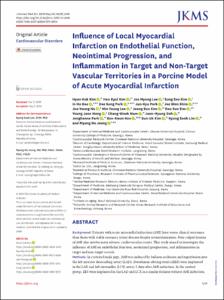KUMEL Repository
1. Journal Papers (연구논문)
1. School of Medicine (의과대학)
Dept. of Internal Medicine (내과학)
Influence of Local Myocardial Infarction on Endothelial Function, Neointimal Progression, and Inflammation in Target and Non-Target Vascular Territories in a Porcine Model of Acute Myocardial Infarction
- Keimyung Author(s)
- Nam, Chang Wook
- Department
- Dept. of Internal Medicine (내과학)
- Journal Title
- Journal of Korean Medical Science
- Issued Date
- 2019
- Volume
- 34
- Issue
- 19
- Abstract
- Background:
Patients with acute myocardial infarction (AMI) have worse clinical outcomes than those with stable coronary artery disease despite revascularization. Non-culprit lesions of AMI also involve more adverse cardiovascular events. This study aimed to investigate the influence of AMI on endothelial function, neointimal progression, and inflammation in target and non-target vessels.
Methods:
In castrated male pigs, AMI was induced by balloon occlusion and reperfusion into the left anterior descending artery (LAD). Everolimus-eluting stents (EES) were implanted in the LAD and left circumflex (LCX) artery 2 days after AMI induction. In the control group, EES were implanted in the LAD and LCX in a similar fashion without AMI induction. Endothelial function was assessed using acetylcholine infusion before enrollment, after the AMI or sham operation, and at 1 month follow-up. A histological examination was conducted 1 month after stenting.
Results:
A total of 10 pigs implanted with 20 EES in the LAD and LCX were included. Significant paradoxical vasoconstriction was assessed after acetylcholine challenge in the AMI group compared with the control group. In the histologic analysis, the AMI group showed a larger neointimal area and larger area of stenosis than the control group after EES implantation. Peri-strut inflammation and fibrin formation were significant in the AMI group without differences in injury score. The non-target vessel of the AMI also showed similar findings to the target vessel compared with the control group.
Conclusion:
In the pig model, AMI events induced endothelial dysfunction, inflammation, and neointimal progression in the target and non-target vessels.
- Keimyung Author(s)(Kor)
- 남창욱
- Publisher
- School of Medicine (의과대학)
- Citation
- Hyun Kuk Kim et al. (2019). Influence of Local Myocardial Infarction on Endothelial Function, Neointimal Progression, and Inflammation in Target and Non-Target Vascular Territories in a Porcine Model of Acute Myocardial Infarction. Journal of Korean Medical Science, 34(19), e145–e145. doi: 10.3346/jkms.2019.34.e145
- Type
- Article
- ISSN
- 1598-6357
- Source
- https://jkms.org/DOIx.php?id=10.3346/jkms.2019.34.e145
- Appears in Collections:
- 1. School of Medicine (의과대학) > Dept. of Internal Medicine (내과학)
- 파일 목록
-
-
Download
 oak-2019-0138.pdf
기타 데이터 / 7.97 MB / Adobe PDF
oak-2019-0138.pdf
기타 데이터 / 7.97 MB / Adobe PDF
-
Items in Repository are protected by copyright, with all rights reserved, unless otherwise indicated.